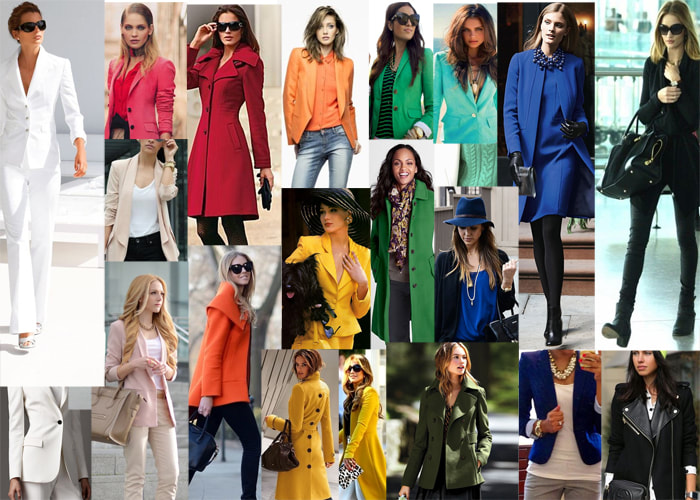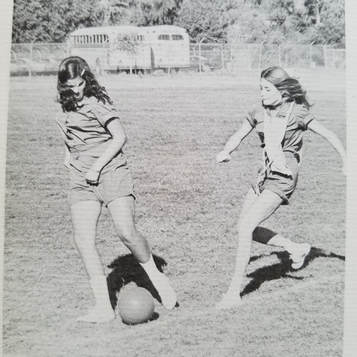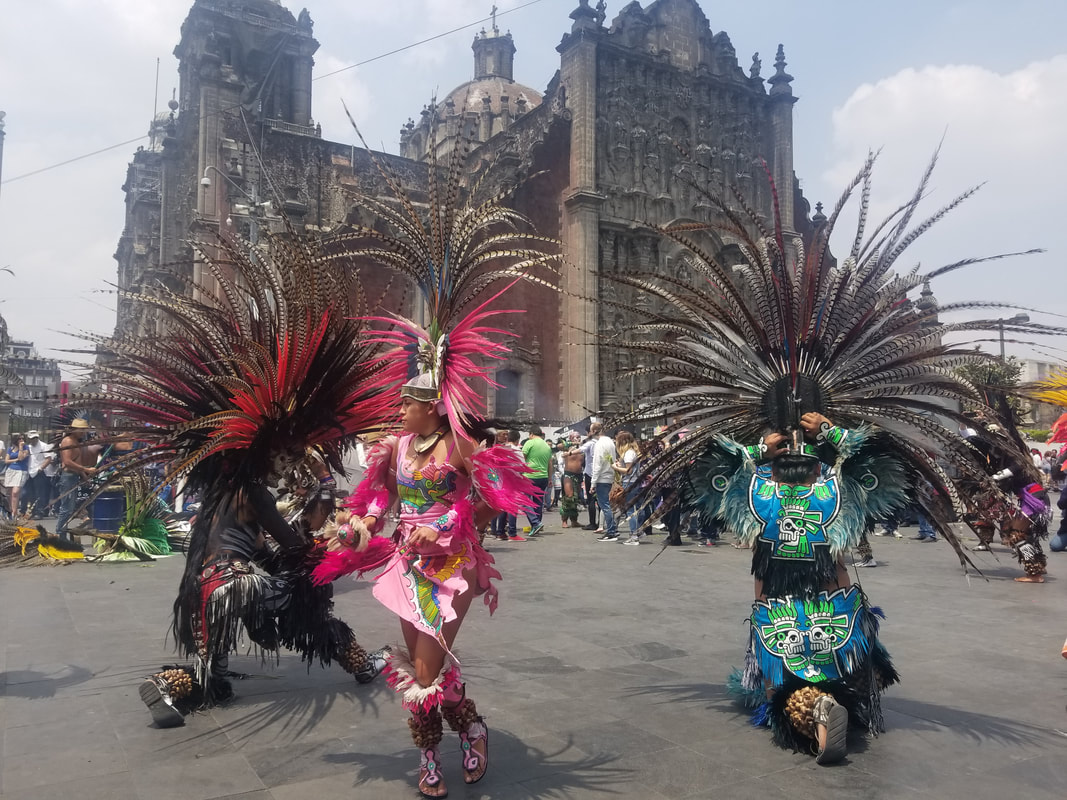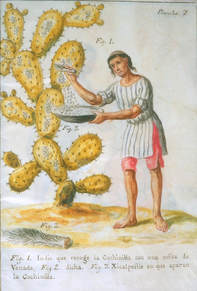Learning Objectives
Color Preferences are cultural.
Why do people wear all black in big cities? In New York City, most people wear black, and also in Mexico City, and London. In these large cities, black is a sign of strength, fitting in, and a sort of mutual shared 'city' identity. It is a sort of uniform, a way to communicate that you all agree on a style, conforming to the norm. There is an expression in design, "The solution is within the constraints." and there are infinite combinations of black clothing details: fabrics, textures, collars, zippers, buttons, hemlines, accessories; each detail making a design statement by the wearer.
What did you wear in high school?
When I was in high school, we were required to 'dress for PE.' this meant we had to wear the loathsome one-piece green jumpsuit, with short sleeves, short pants, and snaps marching up the front to close this example of practical fashion.
Not only were these gym-suits unflattering on everyone, they were made with some mysterious flat weave fabric that did not stretch, was too tight in all the wrong places, and available in only one color, dark green, our school's color. This was my first introduction to 'school colors' and I am surprised that I now like the color green although mostly for dishes and furniture upholstery, not on my body. High school girls were not encouraged to play team sports, until June 23, 1972 when Title IX signed - The amendment read in part, “No person in the United States shall, on the basis of sex, be excluded from participation in, be denied the benefits of, or be subjected to discrimination under any education program or activity receiving Federal financial assistance.” It had a far reaching impact on women in sports and probably PE uniforms. These gym-suits stayed dark green after weekly washings. A surprising accomplishment compared to the boys denim jeans that would fade to light blue after a year of washing machine and dryer abuse. Later, manufacturers decided this 'pre-washed aged denim' look was a fashion statement and began 'stone washing' jeans before they hit the stores. I know they used real stones, since I once found a 1" piece of pumice stone in the pocket of my new jeans.
The required non-stretch gym-suit was during the days of Twiggy when we wore stretch cotton t-shirts and our miniskirts eventually got so short school officials finally decided to allow girls to wear pants to school just before I graduated in 1971. Then came the thick stretchy polyester fabric that made its first debut as 'leisure suits' quickly adopted by senior citizens as 'comfortable,' thereby dooming it as a fashion choice for anyone under the age of 50, until the industry figured out how to knit a thinner textiles and dye it any color other than file cabinet beige. A process called 'filament dyed' where the synthetic material is dyed before or after being extruded into yarn, making the color part of the fiber. Color Meanings -Did you grow up in one country and then move to another? If you did, you may have experienced cultural color meanings that are different than you are used to.
See Color Names & Meanings Regional Colors Identify
Tribes, clans, communities, and sports teams are examples of groups who create identity and promote loyalty with color and design. In Scotland, a kilt and the plaid associated with a family name identify your clan. In the highlands of the South American Andes colorful embroidery signify family ties and history.
Aztec dancers in Mexico City 2018
Colorful Aztec Dancers perform in Mexico City, taking turns leading, when women dance, men kneel. For an excellent article on Cultural fashions see National Geographic article https://www.nationalgeographic.com/travel/travel-interests/arts-and-culture/style-culture-fashion-around-world/
|
Dye Colors by CenturyMinerals are used to create pigments for painting; textiles are colored using natural dyes derived from plants and animals that change the color of natural fibers like linen, cotton, wool and silk. Plant dyes are made from roots, berries, bark, leaves, wood, fungi, and lichens.
Some dyes were so difficult to create that they were reserved for royalty. Royal purple is from of a rare sea creature, whose secretions change from milky white underwater to a powerful dye when exposed to the air, was reserved for royalty by Queen Elizabeth due the the scarcity and cost. Dating back to ancient Phoneticians, Tyrian purple came from a species of sea snail Bolinus brandaris, the dye called Murex, rumored to be worth its weight in gold. "... The Tale of Genji, who called herself Lady Muraki or Lady Purple. The Japanese had their own purple-giving shellfish - Rapana bezoar - but it was very rare..." [2] Collecting CochinealIn 1856 William Henry Perkin was an 18 year old prodigy, at the Royal College of Chemistry in London, who was researching how to make synthetic alternative to quinine, a malaria remedy made from the bark of a tree, and discovered that a residue in a beaker created a beautiful color. Dubbed 'Tyrian Purple' after the famous expensive sea shell dye, this color was actually closer to mauve, a pink-lavender color, historically marking the advent of aniline synthetic dye.
Synthetic dyes are made from petroleum and are sometimes combined with minerals. Many new colors have become available and now, bright purple is inexpensive, magenta and yellow can be so bright that they are compared to 'highlighter' pens. Synthetic fabrics are dyed before being extruded then knitted or woven. Sometimes the color is printed on later. This is where paint and dye overlap both historically and now. To learn more about the history pigments and dyes, I recommend the thorough book, Color, A natural History of the Palette, by Victoria Finlay. Military Colors
Uniforms are designed to demonstrate power and sometimes to hide identity.
Rank and power are communicated by military uniforms. Gold buttons signify high stature and wealth, enough riches to be a dangerous adversary. Red was worn to show the power of British solders and to inspire fear and show their might when they lined up in a row before battle. Blending in with the battlefield was developed during WWII when battleships were painted to hide on the ocean. Beige camouflage means soldiers are less visible in the desert, or green for the forest. One article warns to avoid dressing children in camouflage clothes when camping because if they get lost, it makes them difficult to find. Color of the Year by PantoneWhat is the PANTONE Color of the Year? Since 2000 Pantone has been publishing, on their website, a new color of the year based on global trends in design, fashion, publishing, and architecture. Designers and manufacturers use these color suggestions for new products and branding. Visit their website to see current and past Colors of the Year. https://www.pantone.com
Footnotes
Photo Credits
Collecting Cochineal - By José Antonio de Alzate y Ramírez (21 November 1737 – 2 February 1799 was a priest in Mexico, scientist, historian, cartographer, and journalist.
|
- Home
-
- CHROMA Topics
- Color Spectrum - Light is Energy
- Color in Light
- Color in Nature
- Color in Paint
- Why does paint fade?
- Color Names & Meanings
- Color Phenomena
- Color Perception is Individual
- Color In Fashion
- Color for your home
- Color in Space
- Color Blindness
- Color Blind Interview
- Synesthesia
- Synesthete Deborah Borrowdale-Cox
- Synesthete Stephen Orr, BH&G Editor
-
- Circadian & THERAPY Topics
- Circadian Explained
- Circadian Ganglion Cells
- Circadian Melatonin
- Circadian Animals
- Circadian Research
- Autism & Lighting for the Spectrum
- Blue Light Dimming Apps
- Red Night Lights
- Vitamin D & Light
- SAD - Seasonal Affective Disorder
- Alzheimers and Light Therapy
- Photosensitivity - Light Sensitive Drugs
- Red Light Therapy
- Sleep & Lighting
- Dreams and Second Sleep
- NASA - Lighting in Space & Undersea
- Jet Lag
- Sunglasses
- Chakras
- Crystals, Minerals, & Gemstones
-
- LIGHTing Design Topics
- UV Germicidal Disinfection Light
- LED Lighting Facts Card
- CRI - Color Rendering Index
- LED TM-30
- LED Kelvin Color
- LED LPW
- LED Flicker
- LED Glare
- OLED - Organic LED
- Human Centric Lighting
- Lighting with Daylighting
- Lighting for Healthy Buildings & Zero Net Energy
- Lighting for Healthcare
- Lighting for Horticulture
- Lighting for Hospitality & LED Retrofits
- Lighting for Museums
- Lighting for Seniors & Low Vision
- Lighting Design Tips & Codes
- Parking Lot Lighting
- Solar Lighting for Humanity & World Health
- Davis Insectary Garden
- Santa Barbara Mesa Insectary Garden
- Home
-
- CHROMA Topics
- Color Spectrum - Light is Energy
- Color in Light
- Color in Nature
- Color in Paint
- Why does paint fade?
- Color Names & Meanings
- Color Phenomena
- Color Perception is Individual
- Color In Fashion
- Color for your home
- Color in Space
- Color Blindness
- Color Blind Interview
- Synesthesia
- Synesthete Deborah Borrowdale-Cox
- Synesthete Stephen Orr, BH&G Editor
-
- Circadian & THERAPY Topics
- Circadian Explained
- Circadian Ganglion Cells
- Circadian Melatonin
- Circadian Animals
- Circadian Research
- Autism & Lighting for the Spectrum
- Blue Light Dimming Apps
- Red Night Lights
- Vitamin D & Light
- SAD - Seasonal Affective Disorder
- Alzheimers and Light Therapy
- Photosensitivity - Light Sensitive Drugs
- Red Light Therapy
- Sleep & Lighting
- Dreams and Second Sleep
- NASA - Lighting in Space & Undersea
- Jet Lag
- Sunglasses
- Chakras
- Crystals, Minerals, & Gemstones
-
- LIGHTing Design Topics
- UV Germicidal Disinfection Light
- LED Lighting Facts Card
- CRI - Color Rendering Index
- LED TM-30
- LED Kelvin Color
- LED LPW
- LED Flicker
- LED Glare
- OLED - Organic LED
- Human Centric Lighting
- Lighting with Daylighting
- Lighting for Healthy Buildings & Zero Net Energy
- Lighting for Healthcare
- Lighting for Horticulture
- Lighting for Hospitality & LED Retrofits
- Lighting for Museums
- Lighting for Seniors & Low Vision
- Lighting Design Tips & Codes
- Parking Lot Lighting
- Solar Lighting for Humanity & World Health
- Davis Insectary Garden
- Santa Barbara Mesa Insectary Garden









